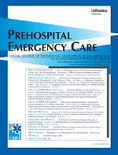
Prehospital Emergency Care
Scope & Guideline
Advancing the Frontiers of Emergency Medicine.
Introduction
Aims and Scopes
- Clinical Effectiveness and Patient Outcomes:
Research that evaluates the effectiveness of various prehospital interventions, treatments, and protocols to improve patient outcomes in emergency situations. - Systems and Operational Research:
Studies that analyze the operational aspects of emergency medical services, including response times, system efficiency, and resource allocation. - Innovations in Prehospital Care:
Exploration of new technologies, methodologies, and practices that enhance the quality and efficiency of care provided in the prehospital environment. - Behavioral Health and Emergency Response:
Investigations into the role of EMS in addressing behavioral health crises and the integration of mental health services in emergency response. - Education and Training in EMS:
Research focused on the education, training, and professional development of EMS personnel to ensure high-quality care and adherence to best practices. - Health Equity and Disparities:
Studies that examine disparities in EMS care delivery and patient outcomes across different populations, emphasizing the need for equitable healthcare access.
Trending and Emerging
- Integration of Technology in EMS:
There is a growing emphasis on the use of technology, such as telemedicine, mobile applications, and advanced monitoring systems, to enhance prehospital care and patient management. - Mental Health and Substance Use Disorders:
Research focused on the management of behavioral health emergencies and substance use disorders has increased, highlighting the role of EMS in addressing these critical issues. - Data Utilization and Predictive Analytics:
The use of big data and predictive analytics to improve EMS response, patient outcomes, and operational efficiency is becoming a prominent theme in current research. - Quality Improvement Initiatives in EMS:
There is a rising interest in quality improvement projects that assess and enhance the standards of care provided by EMS systems, emphasizing continuous learning and adaptation. - Community Paramedicine and Integrated Care Models:
Research on community paramedicine programs and integrated care models is trending, reflecting a shift towards more holistic approaches to patient care in the prehospital setting. - Health Equity and Access to Care:
The focus on health equity, particularly regarding disparities in EMS care and outcomes among diverse populations, is gaining traction as a critical area of research.
Declining or Waning
- Traditional Airway Management Techniques:
Research focused on conventional airway management practices, such as endotracheal intubation, has decreased as newer techniques and technologies, like video laryngoscopy and supraglottic airways, gain popularity. - Basic Life Support (BLS) Protocols:
Studies centering on basic life support protocols have waned in favor of research on advanced life support and innovative resuscitation techniques. - Single-Agent Analgesia Studies:
Research examining the efficacy of single-agent analgesics in prehospital settings is declining as multi-modal analgesia approaches become more favored. - Historical Perspectives on EMS Practices:
There has been a noticeable reduction in publications focusing primarily on historical accounts of EMS practices, as the journal shifts towards contemporary issues and future directions.
Similar Journals

Notarzt
Innovating practices in the realm of critical care.Notarzt is a well-regarded academic journal published by GEORG THIEME VERLAG KG, focusing on critical care, intensive care medicine, and emergency medicine. With an ISSN of 0177-2309 and an E-ISSN of 1438-8693, this German-based journal has been contributing to the medical field since its inception in 1985. Despite being categorized in the Q4 quartile for both Critical Care and Intensive Care Medicine and Emergency Medicine, Notarzt continues to provide a platform for innovative research, case studies, and developments that inform practitioners and researchers alike. With a publication history spanning significant years such as 1993 and 1999 to 2024, Notarzt is dedicated to improving outcomes in emergency and critical care settings through the dissemination of pivotal findings and comprehensive reviews. Although currently not an Open Access journal, it remains an essential resource for professionals striving to stay abreast of developments in their field.
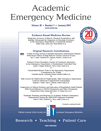
ACADEMIC EMERGENCY MEDICINE
Elevating Research in Critical CareACADEMIC EMERGENCY MEDICINE, published by Wiley, stands as a leading journal in the field of emergency medicine, distinguished by its impressive rankings, including Q1 categories in both Emergency Medicine and Miscellaneous Medicine. With an ISSN of 1069-6563 and an E-ISSN of 1553-2712, the journal covers a broad array of topics relevant to emergency medicine, advancing research from its inception in 1994 up to 2024. Ranked #8 out of 109 in its category, this journal sits in the 93rd percentile according to Scopus, underscoring its significance and influence within the academic community. Although it does not currently offer open access options, its rigorous peer-review process and comprehensive publication standards ensure that only the highest quality research reaches its readership. Aimed primarily at researchers, practitioners, and students in the field, ACADEMIC EMERGENCY MEDICINE serves as an essential resource for those seeking to enhance their understanding and practice of emergency care, making significant contributions to both theory and clinical applications in the field.
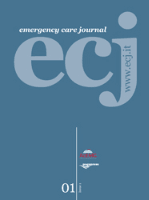
Emergency Care Journal
Empowering Clinicians through Open Access KnowledgeThe Emergency Care Journal is a vital open-access publication dedicated to the field of emergency medical services and nursing, published by PAGEPRESS PUBL. Since its inception in 2005, the journal has aimed to provide a platform for researchers, clinicians, and scholars to share knowledge and advance practices in the critical domain of emergency care. With an ISSN of 1826-9826 and an E-ISSN of 2282-2054, the journal is committed to enhancing accessibility and reaching a global audience. Although its Scopus rankings reflect a competitive landscape, particularly in the ranks of Health Professions and Emergency Medicine, the journal continues to serve as an essential resource for emerging studies and professional insights. Nestled in Italy, the journal seeks to bridge the gap between academic research and real-world application, ultimately improving patient care and outcomes in emergency settings. As it converges into the years 2023 and 2024, Emergency Care Journal stands poised to foster scholarly discussions and innovative research that are crucial to the evolving landscape of emergency medicine.
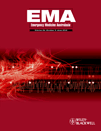
Emergency Medicine Australasia
Empowering Practitioners with Cutting-Edge KnowledgeEmergency Medicine Australasia, published by WILEY, stands as a premier journal in the field of emergency medicine, underlining its significance through its distinguished ranking as Q1 in Emergency Medicine and Q2 in Medicine (miscellaneous) as of 2023. The journal, which has been in circulation since 2004, provides a platform for high-quality research, clinical studies, and reviews that contribute to the advancements in emergency medicine practices. With a Scopus rank of 28 out of 109 in its category, it occupies a notable position within the medical community, boasting a 74th percentile ranking that reflects its impactful contributions to the field. Although it operates primarily on a subscription basis, Emergency Medicine Australasia is essential reading for researchers, practitioners, and students seeking to stay updated on the latest developments and methodologies in emergency care. This journal not only aims to disseminate critical knowledge but also fosters a collaborative environment for sharing innovations that improve patient outcomes and emergency services.
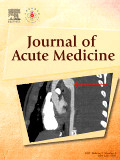
Journal of Acute Medicine
Shaping the future of critical and emergency medicine.Journal of Acute Medicine is a pivotal platform for disseminating cutting-edge research within the fields of Critical Care and Intensive Care Medicine and Emergency Medicine. Published by the Taiwan Society of Emergency Medicine in the Netherlands, this journal serves as a vital resource for healthcare professionals and researchers devoted to advancing acute medical practice. With an ISSN of 2211-5587 and an E-ISSN of 2211-5595, the journal features a collection of high-quality articles that focus on the latest developments and challenges facing emergency healthcare systems. Since its inception in 2011, the journal has achieved a respectable Q3 ranking in both critical care and emergency medicine categories, demonstrating its commitment to scholarly excellence. Although it currently does not operate as an open-access publication, the journal provides a critical forum for exchanging knowledge, fostering collaborations, and enhancing clinical practices, ensuring that it remains an essential read for those involved in acute medical care.

Notfall & Rettungsmedizin
Bridging research and practice in emergency medicine.Notfall & Rettungsmedizin is a leading journal in the field of Emergency Medicine, published by Springer in Germany. With a focus on advancing the science and practice of emergency care, this journal offers a platform for original research, critical reviews, and case studies that address the latest challenges and innovations in the field. The journal ranks in the Q2 category of Emergency Medicine for 2023, reflecting its commitment to high-quality scholarship and impactful research, evidenced by its Scopus ranking of #51 out of 109, placing it within the 53rd percentile. Although it does not provide open access, the content is invaluable for researchers, healthcare professionals, and students engaged in emergency medicine. From its inception in 1999 to its continuous publication through 2024, Notfall & Rettungsmedizin remains a vital resource for disseminating knowledge and fostering professional development in emergency care worldwide.

Annales Francaises de Medecine d Urgence
Pioneering Insights in Emergency MedicineAnnales Françaises de Médecine d'Urgence is a prominent journal dedicated to the field of Emergency Medicine, published by LAVOISIER. With an ISSN of 2108-6524 and E-ISSN of 2108-6591, this journal aims to disseminate vital research and innovative practices pertinent to emergency care, addressing the dynamic challenges faced by healthcare professionals in acute medical settings. While it operates under a non-open access model, it maintains an important role in advancing knowledge in the discipline, evidenced by its categorization in 2023 as Q4 in Emergency Medicine with a Scopus ranking of #85 out of 109, placing it in the 22nd percentile. Spanning years from 2011 to 2024, this journal serves as a platform for researchers, practitioners, and students committed to improving patient outcomes and advancing the science of emergency medicine. With its thoughtfully curated articles and studies, Annales Françaises de Médecine d'Urgence is a crucial resource for anyone who aims to stay at the forefront of developments in emergency medical care.

Eurasian Journal of Emergency Medicine
Empowering professionals with open access to critical findings.Eurasian Journal of Emergency Medicine is a premier journal dedicated to advancing the field of emergency medicine. Published by GALENOS PUBL HOUSE, this renowned open-access journal has been at the forefront of disseminating critical research and innovative practices since its inception in 2003. With an ISSN of 2149-5807 and an E-ISSN of 2149-6048, it provides a platform for researchers, professionals, and students to share their findings and enhance their understanding of emergency medical practices. The journal's commitment to open access ensures that vital knowledge and research are available to a global audience, promoting collaboration and development within the field. As a valuable resource, the Eurasian Journal of Emergency Medicine plays a pivotal role in shaping contemporary emergency care, addressing pressing issues, and exploring advancements that benefit practitioners and patients alike.

Prehospital and Disaster Medicine
Elevating Standards in Prehospital and Emergency NursingPrehospital and Disaster Medicine is a leading peer-reviewed journal published by Cambridge University Press that targets the ever-evolving fields of emergency medicine and disaster management. With an ISSN of 1049-023X and an E-ISSN of 1945-1938, this journal has established its significance within the academic community since its inception, with coverage extending from 1985 to the present. It is widely recognized within its category as evidenced by its 2023 rankings, which position it in the Q2 quartile for both Emergency Medicine and Emergency Nursing. The journal boasts impressive Scopus rankings, standing at Rank #7/32 in Emergency Nursing and Rank #31/109 in Emergency Medicine, demonstrating its relevance and impact in these critical areas. Although it does not offer Open Access, Prehospital and Disaster Medicine is committed to disseminating vital research and innovative practices that address prehospital care, disaster response, and the intersection of these fields, serving as an essential resource for researchers, professionals, and students alike.

Current Emergency and Hospital Medicine Reports
Bridging Research and Practice in Emergency MedicineCurrent Emergency and Hospital Medicine Reports, published by Springer, is a pivotal journal in the field of emergency and hospital medicine. With a commitment to disseminating crucial research and advancements, this journal serves as a platform for sharing high-quality studies that enhance clinical practices and improve patient outcomes. As an important resource for researchers, healthcare professionals, and students, it caters to the growing need for evidence-based knowledge in emergency medicine. Although currently not classified as open access, the journal offers a wealth of information that aligns with the latest innovations and practices in the discipline. By engaging with diverse topics, from clinical interventions to hospital management strategies, it aims to inform and inspire the next generation of practitioners and scholars in this vital field of medicine. With its ISSN of 2167-4884, Current Emergency and Hospital Medicine Reports is dedicated to advancing the frontiers of emergency healthcare through rigorous research and illuminating insights.